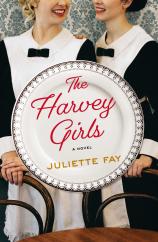Excerpt
Excerpt
The Harvey Girls

Prologue
In 1853, a seventeen-year-old named Fred Harvey emigrated from London to New York City with only a few dollars in his pocket. He got a job as a pot walloper (dishwasher) at a popular restaurant, where he rose up the ranks to line cook and nurtured a lifelong passion for fine dining.
By the age of thirty he was working as a traveling railroad agent, but he never gave up the dream of owning his own restaurant. At the time, steam engines stopped every hundred miles or so to refuel with coal and water. Rustic food stands cropped up at these stations to serve hungry passengers. At best, the offerings were simple; at worst, they resulted in death by food poisoning.
Fred was certain that if he could provide high-quality food at these stops, both he and the railroad would prosper. He approached the Atchison, Topeka and Santa Fe Railway, which had stops from Kansas throughout the Southwest, and in 1876, Fred opened his first restaurant at the Topeka, Kansas, depot. The reception was so enthusiastic that many more Harvey Houses, as they were called, soon followed. In fact, the slogan of the ATSF became “Meals by Fred Harvey.” Thus began the first hospitality empire in America.
Fred’s success was achieved through razor-sharp business acumen and an unwavering demand for quality. His restaurants had white tablecloths, fine silver, excellent food, and arguably the best coffee in the nation. He was remarkably unafraid to try new business methods. This was never more evident than when he hired an all-female waitstaff.
At the time, women’s options for respectable employment were limited to jobs such as being a nurse, secretary, or teacher. Domestic or factory work was for the lower classes. Restaurant service was considered only a few rungs up the ladder from prostitution. Fred Harvey’s problem, however, was that his male waiters tended to get drunk and into fights.
He solved this problem—for himself and for approximately one hundred thousand women who would become not waitresses but “Harvey Girls”—by instituting puritanical rules. They wore uniforms that were about as alluring as a nun’s habit, lived in dorms with strict curfews, and were prohibited from dating other Harvey employees. They had to comport themselves with utmost propriety at all times or risk immediate termination.
The irony is that in return for complying with all these rules, they received unprecedented freedom. Harvey Girls were better paid than women in almost any other profession and could spend that money during generous vacation time, during which they were allowed to ride the trains and stay at other Harvey Houses at no cost. Former Harvey Girls often reported that it was a remarkable education, not only in how to do things well and with care, but also in how to take control of their own destinies.
Many also found love. Until well into the 1900s, the Southwest was populated predominantly by men—ranchers, farmers, prospectors, railroad workers. As the saying went, there were “no ladies west of Dodge City, and no women west of Albuquerque.” Local men were all too happy with the influx of females into their communities.
It’s estimated that about half of all Harvey Girls chose to remain in the Southwest after their service ended, many marrying and raising families there. Thousands of baby boys from these matches were named Fred or Harvey.
Such an honor was understandable. The man not only fed the Southwest and taught it manners… he was also indirectly responsible for populating it.
The Harvey Girls
- Genres: Fiction, Historical Fiction, Women's Fiction
- paperback: 384 pages
- Publisher: Gallery Books
- ISBN-10: 1668095068
- ISBN-13: 9781668095065



